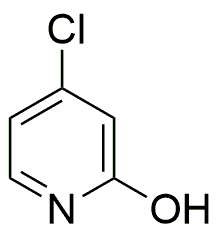4-Chloro-2-hydroxypyridine is widely utilized in research focused on:
- Pharmaceutical Development: This compound serves as an important intermediate in the synthesis of various pharmaceuticals, particularly in the development of antimicrobial agents and anti-inflammatory drugs.
- Agricultural Chemicals: It is used in the formulation of herbicides and fungicides, providing effective solutions for pest control in crops, which helps improve agricultural productivity.
- Analytical Chemistry: The compound is employed as a reagent in analytical methods to detect and quantify metal ions, offering precise results in environmental monitoring and quality control.
- Material Science: It plays a role in the development of specialty polymers and coatings, enhancing material properties such as durability and resistance to environmental factors.
- Research Applications: In academic and industrial research, it is utilized for studying reaction mechanisms and developing new synthetic methodologies, contributing to advancements in organic chemistry.
General Information
Properties
Safety and Regulations
Applications
4-Chloro-2-hydroxypyridine is widely utilized in research focused on:
- Pharmaceutical Development: This compound serves as an important intermediate in the synthesis of various pharmaceuticals, particularly in the development of antimicrobial agents and anti-inflammatory drugs.
- Agricultural Chemicals: It is used in the formulation of herbicides and fungicides, providing effective solutions for pest control in crops, which helps improve agricultural productivity.
- Analytical Chemistry: The compound is employed as a reagent in analytical methods to detect and quantify metal ions, offering precise results in environmental monitoring and quality control.
- Material Science: It plays a role in the development of specialty polymers and coatings, enhancing material properties such as durability and resistance to environmental factors.
- Research Applications: In academic and industrial research, it is utilized for studying reaction mechanisms and developing new synthetic methodologies, contributing to advancements in organic chemistry.
Documents
Safety Data Sheets (SDS)
The SDS provides comprehensive safety information on handling, storage, and disposal of the product.
Product Specification (PS)
The PS provides a comprehensive breakdown of the product’s properties, including chemical composition, physical state, purity, and storage requirements. It also details acceptable quality ranges and the product's intended applications.
Certificates of Analysis (COA)
Search for Certificates of Analysis (COA) by entering the products Lot Number. Lot and Batch Numbers can be found on a product’s label following the words ‘Lot’ or ‘Batch’.
*Catalog Number
*Lot Number
Certificates Of Origin (COO)
This COO confirms the country where the product was manufactured, and also details the materials and components used in it and whether it is derived from natural, synthetic, or other specific sources. This certificate may be required for customs, trade, and regulatory compliance.
*Catalog Number
*Lot Number
Safety Data Sheets (SDS)
The SDS provides comprehensive safety information on handling, storage, and disposal of the product.
DownloadProduct Specification (PS)
The PS provides a comprehensive breakdown of the product’s properties, including chemical composition, physical state, purity, and storage requirements. It also details acceptable quality ranges and the product's intended applications.
DownloadCertificates of Analysis (COA)
Search for Certificates of Analysis (COA) by entering the products Lot Number. Lot and Batch Numbers can be found on a product’s label following the words ‘Lot’ or ‘Batch’.
*Catalog Number
*Lot Number
Certificates Of Origin (COO)
This COO confirms the country where the product was manufactured, and also details the materials and components used in it and whether it is derived from natural, synthetic, or other specific sources. This certificate may be required for customs, trade, and regulatory compliance.


